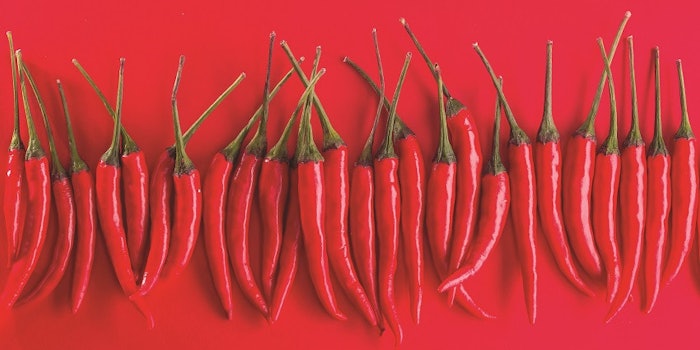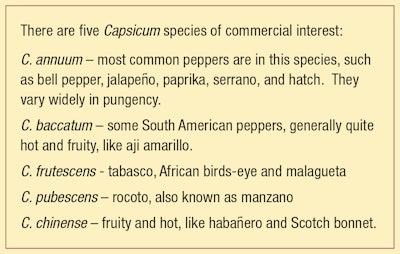
The trend towards hot and spicy foods has been trending up. New product introduction of hot and spicy foods has increased six-fold since 2007.1 “Hot” refers to pungency from spices and extracts such as ginger, mustard, black and white peppers, and most importantly of all, chili peppers of the genus “Capsicum.”
However, chili peppers contribute more than heat. They can be quite flavorful and add a characteristic flavoring on many regional cuisines. Examples include guajillo chilis in Mexican food, Aji Amarillo in Peruvian cuisine, espelette in French Basque cooking, Aleppo peppers in Turkey, Scotch bonnet in the Caribbean and bird’s eye in southeast Asia. As consumers look to new culinary experiences, they also look for authentic flavors, which in many cuisines involve chili peppers. However, chilis and extracts may not be readily available, not flavorful, too hot or lacking solubility for particular food applications. Therefore, a flavor needs to be created. This article describes the chemistry behind the flavor, aroma and pungency of chili peppers to assist in flavor creation.
Capsicum species
Capsicum is a genus in the family Solanaceae, frequently referred to as the “nightshade” family. This family includes some very toxic plants, but besides chili peppers, also includes many other important food crops like tomatoes, potatoes, eggplant and tobacco. Originating in South America, it has spread throughout the globe starting with Christopher Columbus.2
Pungency
Chili peppers are renowned for their “heat.” To avoid confusion with thermal heat, this paper will use the term “pungency.” The causative compounds of pungency are capsaicinoids. The five most abundant capsaicinoids by far are capsaicin, dihdrocapsaicin, nordihydrocapsaicin, homocapsaicin and dihydrohomocapsaicin. (see F-1, a-e). These are all vanillylamides, as are piperine (a pungent agent in black pepper) and gingerol (a pungent compound in ginger). However, there are at least twenty other minor capsaicinoids, which are not believed to be significant in total heat perception due to their low concentration. Pungency is typically measured in Scoville Heat Units (SHU), originally quantified by sensory techniques. Now, pungency is usually quantified by measuring the quantities of the major capsaicinoids by HPLC techniques and using factors to convert them to SHU. For example, pure capsaicin is believed to have a pungency of 16,100,000 SHU and is typically 69% of the total capsaicinoids (see T-1).
Don't Stop Reading!
This isn't the full article. To read on, make sure to click over to the digital edition for the full article and other great insight.













